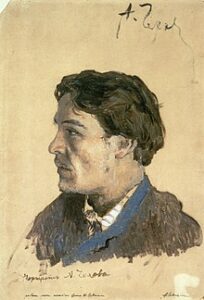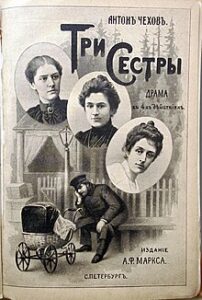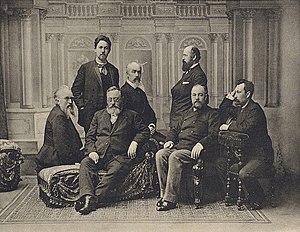Russian author and dramatist Anton Pavlovich Chekhov was educated as a physician and is an academician of the Imperial Academy of Sciences. The master of short writing with a superb sense of humor and undeniable brilliance, the classic of world literature enhanced Russian literature by inventing fresh creative strategies like philistinism and the absence of final morality.
Early life
In January 1860, Anton Chekhov was born in Taganrog. His father owned a colonial goods business and was a small-time grocer and former serf. Anton had two sisters and four brothers, one of them passed away at a young age. The family’s mother was a quiet woman who looked out for the family’s interests; she was the daughter of a businessman. The Chekhov brothers got up at five a.m. every day to sing in the church choir, which was directed by their father. They also assisted their parents in the shop after school.
After completing his studies at the parish school, Anton was enrolled at the Taganrog gymnasium when his father fled to Moscow to avoid debts. To finish his education, the 16-year-old prospective writer decided to stay in his hometown. He moved in with the new owners of his house and used tutoring to assist pay for his stay.
When Chekhov was a high school student, he built his worldview and fell in love with reading and theater. It was during those years that Anton penned his first hilarious stories. The boy had a passion for theater since he was 13 years old, and he even staged home productions for his classmates.
However, Chekhov decided to become a doctor and enrolled in Moscow University’s medical department in 1879, having completed his high school education.
Storytelling works authored by Anton Chekhov
In 1880, Anton Pavlovich’s first printed work was published in the magazine “Dragonfly”; at the time, the future classic was a first-year student. Chekhov then continued to work regularly with the publications “Alarm Clock,” “Spectator,” “Worldly Talk,” and “Light and Shadows.”
Chekhov’s hilarious pieces were first published in the journal “Oskolki” in several cases. The aforementioned magazine released the pieces “Thick and Thin” in 1883, “Chameleon” in 1884, and “Over-Salted” in 1885. The Christmas tale “Vanka” first appeared in the Petersburg Gazette in 1886. The pictures were done by his brother Nikolai Chekhov, and the author signed his early works under the pen name Antosha Chekhonte.
A letter offering Anton Pavlovich a job was sent to him by St. Petersburg in 1886. He received an invitation to the “Novoye Vremya” newspaper. The dramatist wrote the volumes “Motley Stories” and “Innocent Speeches” during this time. As his writings gained traction, Chekhov started signing them using his true name. The author received half of the Pushkin Prize in 1888 for his collection of short stories “At Twilight.”
The author had completed “Drama on the Hunt,” “The Steppe,” “Lights,” and “A Boring Story” by 1889. During his travels, Chekhov gathered material for these pieces. After he quit working with comedy magazines in the late 1980s, the author developed an interest in traveling.
In 1890, the urge to explore led Anton Pavlovich to visit Sakhalin. Traveling to the island required passing through Siberia, where the author gathered inspiration for upcoming works of fiction. Given Chekhov’s condition—he was already experiencing consumption—the journey was difficult for him. The author brought “Across Siberia,” a collection of essays, and “Sakhalin Island,” a book, back from the trip.
Many admirers of Chekhov’s writing particularly recall the tale “Ward No. 6” out of all of his works. In 1892, it was initially printed in the journal “Russian Thought.” The story’s title, which denotes anything strange or bizarre, has become a common term. Numerous phrases from this work have been referenced.
Acts
In Moscow in 1887, Anton Pavlovich’s debut play, “Ivanov,” had its premiere. The Fyodor Korsh Theater hosted the promising playwright’s production. The production was a success, despite the audience’s mixed reactions. The drama was then presented in St. Petersburg, albeit with a few changes.
Playing Trigorin in The Seagull, Astrov in Uncle Vanya, and other roles, Vladimir Nemirovich-Danchenko and Konstantin Stanislavsky presented all of the early Chekhov productions at the Moscow Art Theater.
The Melikhovo period produced the plays “The Seagull” and “Uncle Vanya.” The dramatist also wrote “Three Sisters” at Melikhovo in 1900, a play in which his wife performed wonderfully. The popularity of Olga Knipper as the main female character in Chekhov’s works was replicated in 1903 when The Cherry Orchard, the final piece of the Russian classic, was produced.
The Virtues of Anton Chekhov
The author’s long-held desire was realized in 1892 when he acquired the Melikhovo estate in the Moscow area. He relocated his parents and sister Maria to that location, where she devotedly took up her brother’s legacy. The acquisition of the estate altered Chekhov’s life. Because Anton Pavlovich had a passion for surgery in addition to literature, he once more got the chance to practice medicine.
As a zemstvo doctor in Melikhovo, Chekhov also engaged in charitable activity, constructing a bell tower, a fire station for peasants, and multiple schools. He oversaw the opening of a post office at the railroad station and the building of a highway leading to Lopasnya. The physician also planted over a thousand cherry trees and thinned out woodland sections with elms, oaks, and larches. In addition, Anton Pavlovich paid for the opening of a public library in Taganrog during this time.
Individual existence
There are many love stories in the writer’s personal life. Anton Pavlovich was a tall man (182 cm) who was considered attractive by his contemporaries. Many women were drawn to him because of his charisma. Friends of the writer called them in jest, “Antonovkas.” Chekhov spent years in close contact with his passions. The dramatist did not write his novels in chronological order. Frequently aware of one another, his women showed little urgency to sever their relationships with their partners.
The author developed an interest in Lydia (Lika) Mizinova in 1888. The girl was nineteen years old and Chekhov’s sister’s acquaintance. The writer yearned for freedom and independence, and Lika yearned to be his bride. He had no interest in marrying the girl. For nearly a decade, the man continued to give the beautiful hope despite this. While he relished her presence, he refrained from discussing marriage and having a combined household.
Chekhov denied prospective suitors the opportunity to win Lika’s favor during their initial years of correspondence by making fun of any rivals in her presence. Afterwards, Ignatius Potapenko, a womanizer, was introduced to Lika, who was in love with Anton Pavlovich, by the man himself.
Mizinova conceived and gave birth to a daughter after getting involved with a married admirer. In the early years of life, the youngster passed away. Based on these facts, Anton Pavlovich created Mizinova as the model for Nina Zarechnaya in The Seagull. Following intricate and perplexing games with Potapenko and Chekhov, Lika sought comfort in marriage. She wed theater director Alexander Sanin in 1902.
Anton Pavlovich met Elena Shavrova in the 1980s. A fifteen-year-old girl presented Chekhov with a narrative manuscript and developed an intense romantic interest in him. Five years after they met, the girl got married since she realized there was little hope of reciprocity.
She traveled to Moscow to see family in 1897. When she and Chekhov first met, they started dating. The couple ran away to Crimea. They parted after spending some time together in Yalta. More than any other romantic partner, Elena received roughly seventy-six letters from the writer. In the tale “The Lady with the Dog,” Anton Pavlovich created the character Shavrova.
During the 1898 playwright’s debut of “The Seagull,” he reconnected with his longtime friend Nina Korsh. She did not pass up the opportunity to try her charms on the writer, whom she had been in love with since she was twelve years old. Anton Pavlovich overreached himself. This pastime led to Nina becoming pregnant.
Although it is thought that the author has no living ancestors, information about Nina’s daughter Tatyana’s birth in 1900 can be found online. Due to his affair with Olga Knipper, Chekhov quit the girl, therefore he was unaware of this situation. Korsh kept her pregnancy a secret from the author. Nina traveled to Paris with her parents following the birth of her daughter. Tatyana Antonovna followed after her father’s medical career by becoming a doctor.
It turned out that Olga Knipper was the one who managed to persuade Chekhov to wed her. They got together at a “The Seagull” play rehearsal in 1898. Olga was a stunning and endearing performer. Knipper’s stay at Anton Pavlovich’s dacha in July 1900 set the tone for their future romance. The lovers tied the knot the next year. The pair didn’t have any kids. Despite the woman’s pregnancy, there was no heir.
The success of the writer’s relationship with Knipper is portrayed in conflicting ways in letters from his archive. Olga remained on stage the entire time, and Chekhov resided in Yalta virtually nonstop while managing recurrent bouts of illness. The playwright and his spouse had a lovely courtship and mutual feelings at the start of their love story, which developed into an epistolary romance with infrequent reunions. Ivan Bunin thought that Anton Pavlovich’s frequent absences were compromising his health. Her husband was further concerned since she did not get along with Maria, his adored sister.
Chekhov’s friends thought he would have lived a longer and happier life had he not married Olga. This narrative did not have a particularly dramatic ending. The playwright’s wife was by his side in his final days, not on tour.
One of the writer’s literary acquaintances published the memoirs “A. P. Chekhov in my life” after the writer passed away. Although there is no documentary proof to support Lydia Avilova’s account of events, she stated that passionate passions were in full flow between her and the writer. Anton Pavlovich referred to her as “mother” or “respected” in his correspondence. In order to explain this, Lydia Avilova said that she destroyed the majority of her private letters to the writer.
Historians question the authenticity of her memoirs, speculating that the author intended to draw attention to herself by claiming a well-known colleague’s name.
The Death of Anton Chekhov
Chekhov had a TB infection. At the age of 24, he saw symptoms of consumption in himself for the first time. The writer’s recollections indicate that in 1885, his fever and bloody cough became increasingly apparent symptoms of his disease. When Anton Pavlovich was younger, he received no treatment for tuberculosis. He thought the symptoms were indicative of a different illness.
Afterwards, the author kept his ill health a secret from his loved ones. He did not want to annoy his mother or sister. The dramatist was gravely ill by 1897 and frequently bled from his right lung. This fact compelled him to submit to testing under Professor Alexei Ostroumov’s supervision.
He was brought to the hospital in order to research the signs of Chekhov’s disease. Doctors diagnosed patients and recommended a course of action. The writer started to ask to go home as soon as he felt better. It was Anton Pavlovich’s sincere desire to carry on writing. The writer started having bloody cough episodes in 1898 that would persist for many days. He kept this information from his family.
Additionally, the author gave his heroes agonizing experiences that shaped Chekhov’s life. The piece “The Story of an Unknown Man” is where this transfer is most apparent.
The writer was advised to travel to a number of resorts, some of which were too far for a sick person to travel. After spending the winter of 1898 in Nice, the writer returned to France and purchased a piece of land near Yalta. He eventually relocated to Crimea in the summer after selling his estate in Melikhovo, close to Moscow.
Chekhov went to a vacation in southern Germany with his wife just before he passed away. The author passed away at Badenweiler during the summer of 1904. It was believed that TB was the reason of Chekhov’s demise. The playwright felt worse than usual, and that was when it all began. Chekhov was already saying that he was dying when a doctor approached at his bedside. He requested champagne, took a sip, and passed away.
In 2018, British researchers found blood clot-forming proteins in traces of blood on Chekhov’s preserved shirt in addition to mycobacterium tuberculosis. This gave rise to the theory that Anton Pavlovich’s abrupt death was caused by a blood artery obstruction and cerebral hemorrhage.
The writer’s coffin bearing his body was transported from Germany to Moscow on a carriage bearing the name “Oysters.” The train’s only section with refrigerated cabinets was this one. The funeral was held at the Novodevichy Convent cemetery, and the bones were moved to the Novodevichy cemetery following its abolition.
Modifications to works
More than 500 films in South Africa, Russia, Spain, and even Great Britain were based on the works of Chekhov. When it comes to how many foreign films have adapted Russian classics, the author is in the lead. The silent film “Surgery,” which was the first movie based on Anton Pavlovich’s work, was released in the Russian Empire in 1909; it has not survived.
Popular cinema versions include Nikita Mikhalkov’s “Dark Eyes,” Laurence Olivier’s “Play of the Month” for the BBC, Mikhail Tsekhanovsky’s cartoon “Kashtanka,” and others.
“The Cherry Orchard” is regarded as one of the most well-known Russian dramas performed overseas. The drama debuted on the stage of the Scenic Society Theater in Great Britain seven years after the comedy’s initial 1904 production at the Moscow Art Theater.
Memory
Chekhov’s admirers are still interested in his works and biography. The paintings “Farewell, Doctor Chekhov!” (2007), “Admirer” (2012), and “Anton Chekhov 1890” (2015) are tribute to the playwright’s life.
The Russian author’s name appears on theaters, hospitals, libraries, and even geographical and astronomical things, such as an asteroid and a crater on Mercury. The writer is honored with the namesake of a river passenger ship that travels along the Don and Volga between Rostov-on-Don and Moscow, as well as a variety of roses. Even the protagonist of Gene Roddenberry’s hit television series Star Trek was given the surname Chekhov.
Numerous monuments honor the protagonists of Anton Pavlovich’s novels, such as Kashtanka, a woman walking a dog, and a guy holding a case, in addition to the dozens of monuments honoring the author.
In addition to Russia, the publicist’s images were frequently included on stamps from the Gambia, Monaco, and even the Vatican.
